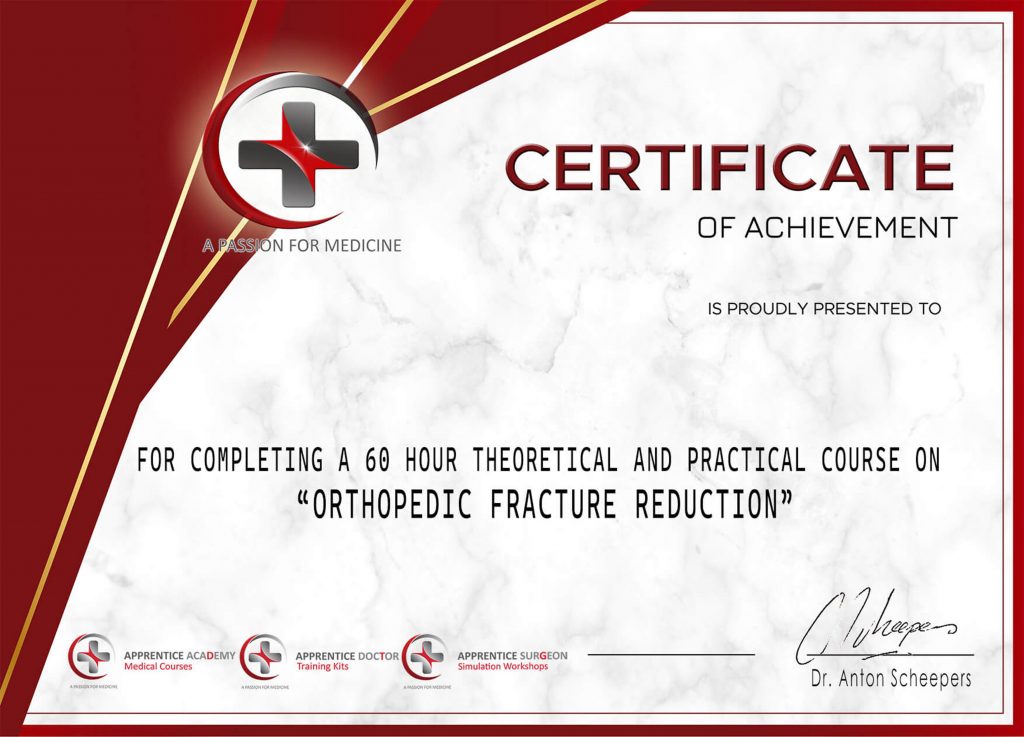Perform amazingly realistic simulation surgery. Get practical experience and insight into basic surgical principles. Suture the surgical wound in layers. Practice various open and closed reduction methods. Practice at home or wherever you are.
The Kit
Click here to order your Apprentice Doctor® Fracture Reduction Kit
The Course
After completing the Apprentice Doctor Academy Orthopedic Fracture Reduction Course, students should have a good understanding of:
- Principles of asepsis
- Surgical sterility
- Basic bone biology and physiology
- Basic anatomy of the human skeleton
- Biomechanical considerations in orthopedic surgery
- Radiological considerations
- Basic principles and methods of fracture reduction, fixation, and immobilization
- Simple fracture classifications
- Healing of the fracture site
- Common complications
In addition to this, the student will have the following healthcare/medical skills:
- Preparing a sterile surgical field
- Identification of common surgical landmarks
- Sharps safety
- Surgical retraction
- Blunt dissection
- Fracture reduction
- Fracture fixation
- Place a bone plate with monocortical screws
- Place a bone plate with bicortical screws
- Closing (suturing) a surgical wound
- Placing a dressing
- Properly discarding medical waste and sharps
The student will have a career perspective regarding:
- A typical operative procedure performed by most orthopedic surgeons on a regular basis – based on experiential learning.
- The various career opportunities available to orthopedic surgeons.
Who Should Enroll In This Course?
– High School students in Grade 10 to 12
– Students at premed years 1-4 levels.
Setting
Home-based learning
Time Allowed
Please check your subscription details in your profile to see when your course access expires.
Duration
+-30 Hours (including practical projects).
The Apprentice Doctor Academy recommends that the student not rush through the course (not more than 3 hours per day) to allow for consolidation of the information. The course could be done in less than a week with full-time study; however, it is recommended that you not rush and instead allow the information to consolidate in your mind.
Furthermore we recommend that you briefly review the previous day’s work before continuing each day. This will also consolidate the knowledge in your mind.
Requirements/Instructions
— Register with Apprentice Doctor Academy
— Enroll in Course
— Simulation Kit (optional but recommended to complete the practical projects and practice the techniques you learn)
Certified Credits
Equivalent to sixty shadowing hours
Warnings
– The Apprentice Doctor® Fracture Reduction Course and accompanying Simulation Kit (including all items and instruments in the kit) are exclusively intended for educational and training purposes. No instrument or item may be used in a real clinical medical setting (emergency or otherwise).
– Without a formal medical qualification you may open yourself to medico-legal litigation if applying these techniques on the public.
– The surgical gloves contain latex. We do supply latex-free gloves as an alternative on request.
– The Apprentice Doctor® Fracture Reduction Course and Simulation Kit is suitable for students over 15 years of age. Adult supervision is recommended for students below the age of 18 years.

